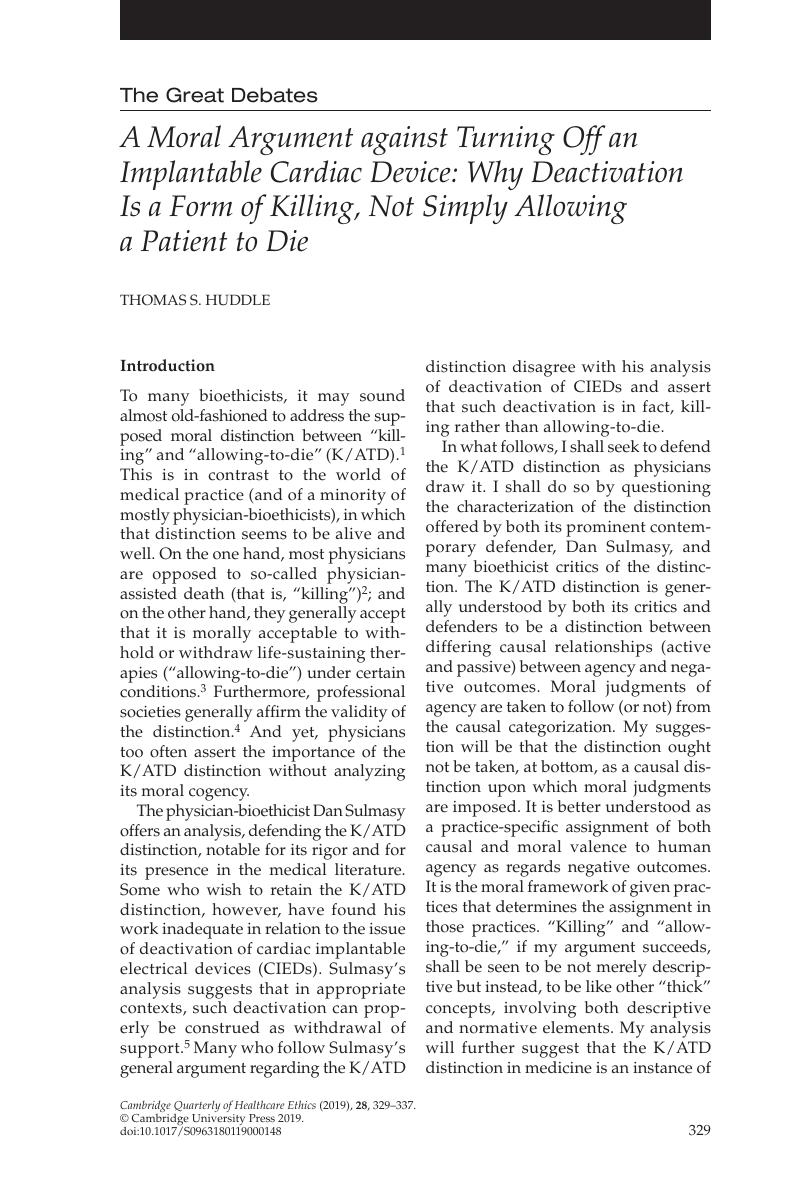Published online by Cambridge University Press: 22 May 2019

1. See, for instance, Rachels, J. The End of Life: Euthanasia and Morality New York: Oxford University Press; 1986, Ch. 7;Google Scholar Brock, D. Taking human life. Ethics 1985;95:851–65.CrossRefGoogle ScholarPubMed
2. Solomon, MZ, O’Donnell, L, Jennings, B, Guilfoy, V, Wolf, SM, Nolan, K et al. Decisions near the end of life: professional views on life sustaining treatments. American Journal of Public Health 1993;83:14–23;CrossRefGoogle ScholarPubMed Caralis, PV, and Hammond, JS Attitudes of medical students, house staff, and faculty physicians toward euthanasia and termination of life-sustaining treatment. Critical Care Medicine 1992;20:683–90.CrossRefGoogle Scholar More recent, if less rigorous, evidence for physician opinion on physician assisted suicide are the results of an online poll of NEJM’s USA readers, of which 67% opposed physician assisted suicide: Colbert, JA, Schulte, J, Adler, JN. Physician-Assisted suicide—polling results. New England Journal of Medicine 2013;369:e15(1).CrossRefGoogle ScholarPubMed
3. Asch, DA, Faber-Langendoen, K, Shea, JA, Christakis, NA. The sequence of withdrawing life-sustaining treatment from patients. American Journal of Medicine 1999;107:153–56.CrossRefGoogle ScholarPubMed
4. Bone, RC, Rackow, EC and Weg, JG. Ethical and moral guidelines for the initiation, continuation, and withdrawal of intensive care. Chest 90;97:949–58.CrossRefGoogle Scholar American Thoracic Society. Withholding and withdrawing life-sustaining therapy. Annals of Internal Medicine 1990;115;478–85.Google Scholar Truog, RD, Campbell, ML, Curtis, JR, Haas, CE, Luce, JM, Rubenfeld, GD et al. Recommendations for end-of-life care in the intensive care unit: A consensus statement by the American Academy of Critical Care Medicine. Critical Care Medicine 2008;36:953–63.CrossRefGoogle ScholarPubMed
5. Sulmasy, DP. Within you/without you: biotechnology, ontology, and ethics. Journal of General Internal Medicine 2008 Jan;23 Supplement 1:69–72.CrossRefGoogle Scholar
6. For a recent explication of this position, see Miller, FG, Truog, RD and Brock, DW. Moral Fictions and Medical Ethics. Bioethics 2010;24:453–60.CrossRefGoogle ScholarPubMed
7. Sulmasy, DP. Killing and allowing to die: another look. Journal of Law Medicine and Ethics 1998;26:55–64.CrossRefGoogle ScholarPubMed
8. Mueller, PS, Hook, CC, and Hayes, DL. Ethical analysis of withdrawal of pacemaker or implantable cardioverter-defibrillator support at the end of life. Mayo Clinic Proceedings 2003;78:959–63.CrossRefGoogle ScholarPubMed
9. Kapa, S, Mueller, PS, Hayes, DL and Asirvatham, SK. Perspectives on withdrawing pacemaker and implantable cardioverter-defibrillator therapies at end of life: Results of a survey of medical and legal professionals and patients. Mayo Clinic Proceedings 2010;85:983.CrossRefGoogle Scholar
10. See note 7, Sulmasy 1998, at 57.
11. McMahan, J. “Killing, Letting Die, and Withdrawing Aid.” Ethics 103(1993):250–79 at 262.CrossRefGoogle ScholarPubMed
12. Cf. Cartwright, N. Hunting Causes and Using Them: Approaches in Philosophy and Economics. Cambridge: Cambridge University Press, 2007;CrossRefGoogle Scholar Driver, J. Attributions of causation and moral responsibility. Moral psychology 2(2008):423–40;Google Scholar Hitchcock, C. and Knobe, J. Cause and norm. Journal of Philosophy 11(2009):587–612;CrossRefGoogle Scholar Alvarez, M. “Letting happen, omissions and causation.” Grazer Philosophische Studien 61(2001):63–81;CrossRefGoogle Scholar and Godfrey-Smith, P. Causal pluralism. Oxford Handbook of Causation 2009:326–37.Google Scholar
13. As is suggested by recent empirical work on how people draw these distinctions. See Cushman, F., Knobe, J., & Sinnott-Armstrong, W. Moral appraisals affect doing/allowing judgments. Cognition 2008;108:281–89.CrossRefGoogle ScholarPubMed
14. Compare with Cartwright, on causation as a family resemblance concept, note #15, Cartwright 2007; and Cartwright, N. “Comments on Longworth and Weber.” Analysis Reviews 2010;70:325–330.CrossRefGoogle Scholar
15. For example, Woolard, F. The Doctrine of Doing and Allowing II: The Moral Relevance of the Doing/Allowing Distinction. Philosophy Compass 2012;7:465.Google Scholar FitzPatrick, W. Intention, Permissibility and Double Effect. Oxford Studies in Normative Ethics 2012;2:97–127.CrossRefGoogle Scholar